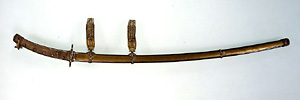Very high technology is gathered in the manufacturing method of the Japanese sword to realize 3 elements said to be able to "cut it well without turning without compromising" in a very high dimension at the same time. I write below down the outline.
Making of the high quality steel
Carburizing the melted iron sand in a furnace with a foot bellows
I call steel becoming the materials of the Japanese sword sum steel (it will be heated) or ball steel (a Tama steel). The ball steel is made with "the carburizing the melted iron sand in a furnace with a foot bellows" that is the Japanese original steel manufacture method. I can get high quality steel I realize high speed reduction at low temperature unlike the steel manufacture method to assume the iron ore of many foreign countries raw materials by using iron sand for raw materials, and I compare it with the steel manufacture method that, besides, is modern, and to use little iron sand of impurities as raw materials.
I reduce water
I beat the ball steel which I heated with a mallet (soil) and make a thin flat board. When I put this in water, and immediate cold water passes, exfoliation is scattered the part which unnecessary carbon enters. I say (I pass without looking and do it) "water reduces" this or and I "push the water". It is the making of metal which here passes, and it does it, and is called work.
I excite the product
The lump which I turn on this firing and hardened is called (へしがね) and I swat it and crush it with a mallet to a small piece of iron. I divide it into much hard iron and little soft iron of the carbon minute from the piece and I pile up these pieces of iron on the point of the tool of the training use to be called "a lever" separately and wrap it with a Japanese paper. I add a straw ash to circumference, and, furthermore, I can write clay juice, and a firebed enter, and surface clay heats can dissolve it. A straw ash and silicic acid of the clay melt to glass by heating and cover the surface of the adhesion side of the steel and prevent what firing of the steel decreases by obstructing the oxidation film (iron oxide (II)) formation of the iron and does. ※The prevention of oxidation film by the silicic acid which melted is used for arrival at pressure of the steel in the case of later forge welding using a similar phenomenon. I swat it in a mallet and strengthen it to around 6*9cm. If a piece of iron is not enough, I pile it up more and heat and swat it in a mallet and mold it and do it to quantity of around 1.8-2.0kg of the indispensability. The above "excites the product", and it is a の process. The malleable iron called pig iron and kitchen knife iron with much quantity of carbon besides ball steel excites the product and works on the next bottom discipline.
Training(I train a bottom)
I repeat "lapel training" I can enter, and to fold a fold centrally when I swat it and thin the block which became red-hot with a mallet (soil) in length and breadth direction and perform it. By the way, I became the etymology of the words "that "the sledge hammersmith" that a swordsmith (a front seat) and a pupil (the first move) beat the sword blade with a mallet in turn chimed in" on. Around five or six times lapels are performed at this stage.
Subscribe to:
Post Comments (Atom)

No comments:
Post a Comment